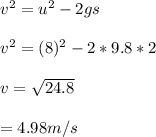
Physics, 16.11.2019 04:31 rosepederson80
Agirl of mass m1=60 kilograms springs from a trampoline with an initial upward velocity of v1=8.0 meters per second. at height h=2.0 meters above the trampoline, the girl grabs a box of mass m2= 15 kilograms. for this problem, use g=9.8 meters per second per second for the magnitude of the acceleration due to gravity. a)what is the speed of the girl immediately before she grabs the box? b)what is the speed of the girl immediately after she grabs the box? c)what is the maximum height that the girl (with box) reaches? measure with respect to the top of the trampoline

Answers: 1


Other questions on the subject: Physics

Physics, 22.06.2019 18:50, rurbanok12
8.29 two streams containing pyridine and acetic acid at 25°c are mixed and fed into a heat exchanger. due to the heat-of-mixing effect, it is desired to reduce the temperature after mixing to 25°c using a stream of chilled ethylene glycol as indicated in the diagram. calculate the mass flow rate of ethylene glycol needed. the heat capacity of ethylene glycol at these conditions is approximately 2.8 kj/(kg k), and the enthalpy change of mixing (δmixh) is given below.
Answers: 3


Physics, 23.06.2019 13:30, ladeshak5981
The goal of this experiment was to answer the question, "how does diffraction occur? " suppose you formulated this alternate hypothesis: if the gap width is increased while keeping wavelength constant, then the observed diffraction will decrease because the less the ratio between wavelength and gap width is, the smaller the observed diffraction angle will be. to test this hypothesis, you would change the gap widthdiffraction anglewavelength and observe the gap widthdiffraction anglewavelength in the system. therefore, the independent variable would be the gap widthdiffraction anglewavelength and the dependent variable would be the gap widthdiffraction anglewavelength.
Answers: 1

Physics, 23.06.2019 17:00, isabeltorres5
Conceptualize notice how this problem differs from our previous discussion of gauss's law. the electric field due to point charges was discussed in the previous section. now we are considering the electric field due to a distribution of charge. we found the field for various distributions of charge in the chapter entitled electric fields by integrating over the distribution. this example demonstrates a difference from our discussions in the previous chapter. in this chapter, we find the electric field using law. categorize because the charge is distributed uniformly throughout the sphere, the charge distribution has spherical symmetry and we can apply gauss's law to find the field. analyze note that the following conditions can be used to determine a suitable gaussian surface. condition (1): the value of the electric field can be argued by symmetry to be constant over the portion of the surface. condition (2): the dot product e â· da can be expressed as a simple algebraic product e da because e and da are parallel.
Answers: 3
You know the right answer?
Agirl of mass m1=60 kilograms springs from a trampoline with an initial upward velocity of v1=8.0 me...
Questions in other subjects:





Mathematics, 16.12.2020 20:10

Mathematics, 16.12.2020 20:10


History, 16.12.2020 20:10

Mathematics, 16.12.2020 20:10

Mathematics, 16.12.2020 20:10

 The speed of the girl immediately after she grabs the box =
The speed of the girl immediately after she grabs the box =  The maximum height that the girl reaches with the box =
The maximum height that the girl reaches with the box = 














